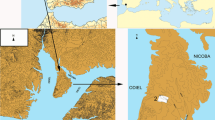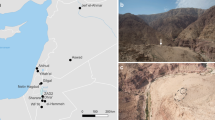Abstract
The analysis of botanical macro-remains (seeds, fruits and wood) from the fortress site of Îgîlîz, situated in the Anti-Atlas mountain range of southern Morocco, provides a first glimpse of the plant economy of a medieval rural community in this part of North Africa. Considered as the original stronghold of the religious community led by Ibn Tûmart, the founder of the Almohad dynasty, the site was occupied from the 10th to the 13th century a.d. The crop assemblage identified from ashy contexts in a central grouping of buildings (the qasba) comprises barley (Hordeum vulgare), sorghum (Sorghum sp., earliest occurrence known so far from Morocco), wheat (Triticum sp.) and a pulse (Lathyrus sativus/cicera). Several arboreal fruit species are also identified: fig (Ficus carica), almond (Prunus dulcis), date palm (Phoenix dactylifera), grapevine (Vitis vinifera) and argan (Argania spinosa). The latter, predominant in the archaeobotanical record in the form of both fruit and wood remains, is of particular interest as it is the first time that this species, endemic to south-western Morocco and of prime economic interest regionally, has been identified from an archaeological context. In the past, as today, the argan tree seems to have played a major role in village economies as a source of wood for fuel and construction, fodder for livestock and food in the form of an edible oil, extracted from the oleaginous seeds. This article focuses on present and past uses of Argania spinosa as well as on the ecology and morpho-anatomy of this emblematic species.












Similar content being viewed by others
References
Ballouche A, Marinval P (2003) Données palynologiques et carpologiques ur la domestica tion des plantes et l’agriculture dans le néolithique ancien du Maroc septentrional (site de Kaf Taht El-Ghar). Revue d’Archéométrie 27:49–54
Bani-Aameur F (2001) Floraison et production de fruits de l’arganier. In: Hamon S (ed) Des modèles biologiques à l’amélioration des plantes. IRD:174–179
Bellakdar J (1997) Contribution à l’étude de la pharmacopée traditionnelle au Maroc: la situation actuelle, les produits, les sources du savoir. Enquête ethnopharmacologique de terrain réalisée de 1969 à 1992. Thèse de l’Université de Metz, Centre des Sciences de l’Environnement
Charrouf Z, Guillaume D (1999) Ethnoeconomical, ethnomedical and phytochemical study of Argania spinosa (L.) Skeels: a review. J Ethnopharmacol 67:7–14
El Alaoui N (2006) L’Arganier: arbre du Maroc. De la récolte du fruit à l’extraction de l’huile. Bulletin de la Société des Amis du Muséum national d’histoire naturelle et du Jardin des Plantes 228:49–53
Fennane M, Ibn Tattou M, Mathez J, Ouyahya A, El Oualidi J (1999) Flore pratique du Maroc. Manuel de détermination des plantes vasculaires. Pteridophyta, Gymnospermae, Angiospermae (Lauraceae—Neuradaceae). vol 1. Travaux de l’institut Scientifique, Série Botanique 36, Rabat
Fuller DQ, Stevens CJ (2009) Agriculture and the development of complex societies: an archaeobotanical agenda. In: Fairbairn A, Weiss E (eds) From foragers to farmers. Papers in honour of Gordon Hillman, Oxbow Book, pp 37–57
Grau Almero E, Pérez Jordà G, Iborra Eres MP, Rodrigo Garcia MJ, Rodriguez Santana CG, Carrasco Porras MS (2001) Gestión de recursos y economía. In: Aranegui Gascó C (ed) Lixus, colonia fenicia y ciudad púnico-mauritana. Anotaciones sobre su ocupación medieval. Saguntum extra 4, pp 191–230
Ibáñez JJ, Peña-Chocarro L, Zapata L, Urquijo González EJ, Moreno García M (2002) Argile et bouse de vache. Les récipients de la région Jbâla (Maroc). Techniques et Culture 38:175–194
Knippertz P, Christoph M, Speth P (2003) Long-term precipitation variability in Morocco and the link of the large-scale circulation in recent and future climates. Meteorol Atmos Phys 83:67–88
McGregor HV, Dupont L, Stuut J-BW, Kuhlmann H (2009) Vegetation change, goats, and religion: a 2000-year history of land use in southern Morocco. Quat Sci Rev 28:1,434–1,448
Msanda F, El Aboudi A, Peltier J-P (2002) Originalité de la flore et de la végétation de l’Anti-Atlas sud-occidental (Maroc). Feddes Repert 113:603–615
Msanda F, El Aboudi A, Peltier J-P (2005) Biodiversité et biogéographie de l’arganeraie marocaine. Cahiers Agricultures 14:357–364
Naggar M, Mhirit O (2006) L’arganeraie: un parcours typique des zones arides et semi-arides marocaines. Sécheresse 17:314–317
Peña-Chocarro L, Zapata L, González Urquijo J, Ibañez JJ (2000) Agricultura, alimentaciόn y uso del combustible: aplicaciόn de modeles etnográficos en arqueobotánica. Saguntum extra 3:403–420
Pérez Jordà G (2005) Capítulo XII. Estudio paleocarpológico. Saguntum extra 6:221–228
Rocher P (1926) L’arganier. Annales de Géographie 35:259–267
Simenel R, Michon G, Auclair L, Thomas Y, Romagny B, Guyon M (2009) L’argan: l’huile qui cache la forêt domestique. De la valorisation du produit à la naturalisation de l’écosystème. In: Les produits de terroir au service de la diversité biologique et culturelle? Armand Colin, Paris, Autrepart 50:51–74
Van Staëvel J-P, Fili A (2006) “Wa-wasalnâ ‘alâ-barakat Allâh ilâ Îgîlîz” à propos de la localisation d’Îgîlîz-des-Harġha, le Hisn du Mahdî Ibn Tûmart. Al-Qantara 27:155–197
Zapata L, Ibañez JJ, González Urquijo J, Peña-Chocarro L (2003a) Las casas de cubierta vegetal del Rif occidental: aspectos arquitectónicos, simbólicos y sociales. El Pajar. Cuaderno de Etnografía Canaria 14:137–143
Zapata L, Peña-Chocarro L, González Urquijo J, Ibañez Estévez JJ (2003b) Ethoarchaeology in the Moroccan Jebala (western Rif): wood and dung as fuel. Africa Praehistorica 15:163–175
Edited manuscripts
Al-Zuhrî (12th c. AD) Kitâb al-Dju‘râfiyya (Livre de géographie), Ed. M. H. Sadok, Cairo
Al-Bakrî (year of death 1094 AD) Description de l’Afrique septentrionale. Translation McG de Slane, (1st édition 1859) Paris
Al-Himyarî, (year of death 1326 AD) Al-Rawd al-mi’târ, (ed. 1975) Beyruth
Al-Idrîsî (year of death 1165 AD) Nuzhat al-mushtâq, Cairo Anonymes (12th c. AD) Kitâb al-Istibsâr, ed. S.Z. ‘Abd al-Hamîd, (2nd ed. 1985) Casablanca
Ibn al-Baytâr (13th c. AD) Al-Adwiyya al-mufrada, vol 4. Traité des simples. Translation L. Leclerc. New edition, Institut du Monde arabe (ed. 1987) Paris
Ibn Khaldoun, (1332–1406 AD) Kitâb al-’Ibar, vol 6, Beyruth
Léon l’Africain (year of birth 1488 AD). Description de l’Afrique, vol 1 (ed. 1983), Beyruth
Marmól (dead after 1559 AD) Afrique, 3 volumes. Vol 2 (ed. 1984) Rabat
Acknowledgments
We are grateful to M. Lemoine, CNRS, for preparing the cross-section of the hard seed coats of argan fruit. This international cooperation research program is supported by the Foreign and European Office (France), the Casa de Velázquez (Madrid), the INSAP (Rabat), the University Choaib Dokkali (El Jadida) and the French research teams UMR 8167 and UMR 5648. Thanks also to the anonymous reviewers for their corrections and helpful suggestions.
Author information
Authors and Affiliations
Corresponding author
Additional information
Communicated by F. Bittmann.
Rights and permissions
About this article
Cite this article
Ruas, MP., Tengberg, M., Ettahiri, A.S. et al. Archaeobotanical research at the medieval fortified site of Îgîlîz (Anti-Atlas, Morocco) with particular reference to the exploitation of the argan tree. Veget Hist Archaeobot 20, 419–433 (2011). https://doi.org/10.1007/s00334-011-0306-2
Received:
Accepted:
Published:
Issue Date:
DOI: https://doi.org/10.1007/s00334-011-0306-2




